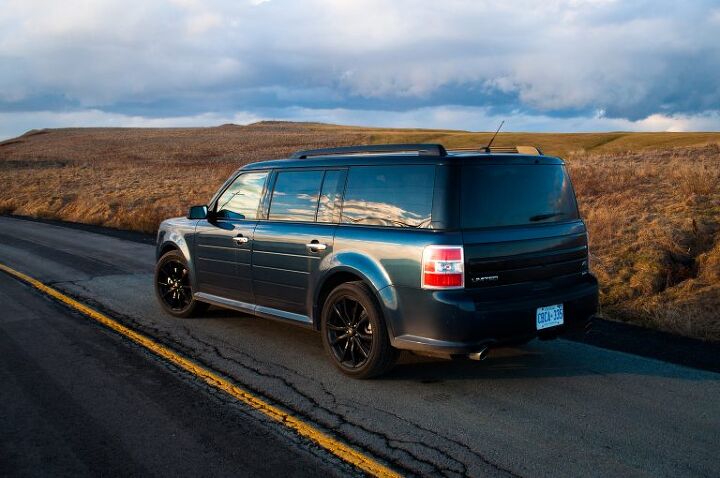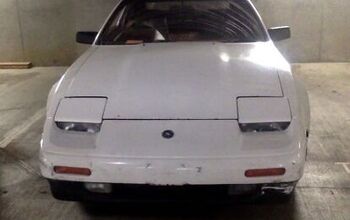2017 Ford Flex Limited EcoBoost Review - It's Been Almost A Decade
2017 Ford Flex Limited
My sister hates the Ford Flex.
She’s never driven a Ford Flex, mind you. She just hates the way it looks.
I, on the other hand, am a huge fan of the Ford Flex’s exterior design, particularly in Blue Jeans paint, particularly without these black wheels.
There are only two sides to this argument. There is no middle ground on which you stand and declare, “Meh, it’s alright.” Since 2008, consumers have fallen on either one side of the fence or the other. You either love the Ford Flex, or you hate the Ford Flex.
Based on the Flex’s lack of marketplace success, there are apparently too many haters. Some nine years after the Flex was launched, inspired in 2008 by the 2005’s Ford Fairlane Concept, Ford’s alternative crossover is increasingly forced into an ever-narrowing niche. The style quotient remains high — at least in the eyes of those who’ve always loved it — but the Flex now manifests too many signs of old age in a market full of remarkably competent and more popular challengers.
THIS FLEX
Suicide doors, a tailgate that opened every which way, and boxy styling cribbed from then Ford-owned Land Rover foretold Ford’s replacement for the Freestyle, which would become the Taurus X by the time the production Flex rolled around. Built on Ford’s D4 platform (an update of the Freestyle/Five Hundred D3 platform based on an updated version of Volvo’s P2 platform), the Canadian-built Ford Flex arrived in 2008 as a 2009 model. Ford hoped to sell 100,000 copies of the Flex per year but has averaged fewer than 28,000, never once topping the 40,000 mark in the United States.
EcoBoost availability in 2010, a refresh for the 2013 model year, and minor updates throughout its tenure — there’s SYNC3 now, for instance — have never inspired an increase in demand.
Loaned to us for the week by Ford, this 2017 Ford Flex arrived in top-trim Limited guise. The basic $30,920 Flex SE comes only with the 3.5-liter, naturally aspirated, 287-horsepower V6 and front-wheel drive. The $33,625 Flex SEL makes all-wheel drive a $1,950 option. AWD is still a $1,950 option on the $39,125 Flex Limited, but the Limited also makes available the 3.5-liter twin-turbo EcoBoost engine.
If you want the 3.5 EB, however, you’ll have to select AWD and a 303A Equipment Group that drives the price up to $47,820. To that base Flex EcoBoost price, our tester added $2,360 in options, including the multipanel vista roof and an appearance package with a black roof and black wheels.
The resulting $50,180 MSRP is frightening, but keep in mind, Ford is currently discounting that price by $2,750 before negotiations even begin.
THIS FLEX’S FAULTS
“YOU’VE SELECTED DRIVE, ONE NOTCH PAST NEUTRAL!” No need to be angry about it, Babushka.
The steering wheel buttons for audio and cruise control are positively archaic and fiddly to operate. The doors are approximately as heavy as a SportKa. The wavy appliqué that stretched across the dashboard was left over from some Ford designer’s circa 2008 basement reno. It was stylish. So were puffy shoulder pads.
Yet in more practical terms, it’s the Ford Flex’s prodigious heft that speaks loudly of its outdated architecture. The Flex Limited EcoBoost is nearly 200 pounds heavier than the Toyota Highlander Limited Platinum, more than 500 pounds heavier than a Honda Pilot Touring and Mazda CX-9 Signature, and nearly 900 pounds heavier than the new GMC Acadia Denali. Granted, the largest of this group, the Pilot, is 7.3-inches less lengthy than the Ford Flex.
As a result, the 365-horsepower turbocharged V6 doesn’t make the Flex feel that quick off the line, although the hilarious levels of torque steer would lead you to believe otherwise. But once all that inertia is overcome, once you’ve begun to push a brick through the air, and once the 20-inch wheels start rolling, the powerplant comes into its own, providing ample passing power and outstanding off-ramp enthusiasm. A Nissan Pathfinder this is not.
But dipping into the reserves of an artificially aspirated engine that doesn’t make max power until 5,500 rpm has a deleterious impact on fuel economy. We averaged a frightening 16 miles per gallon in a mix of urban and highway driving. An F-150 with the 3.5-liter EB is less thirsty.
Thanks to the 117.9-inch wheelbase, ride quality isn’t bad, but the 20-inch wheels on 255/45R20 Hankook Optimos tend to crash about on rougher roads. Long gone is the time when enlarged wheels and low-profile rubber were used to enlarge a car’s contact patch. These wheels are here purely for style on a vehicle that isn’t — and perhaps can’t be — remotely athletic. There’s a pervasive sense of burden, of mass-inspired recalcitrance. The Flex doesn’t like to change directions and rolls excessively when forced to do so.
Making matters worse, all that weight has not created a vehicle that manifests modern structural rigidity. In only its second week-long test since coming off the Oakville, Ontario, production line, this Flex already revealed the early signs of creaking and groaning around the rear doors when traversing uneven pavement.
THIS FLEX’S FORTES
Though the market is littered with three-row crossovers, few utility vehicles can adequately live up to the minivan when it comes to regular three-row use. The Flex’s mechanisms for accessing the third row aren’t up to snuff, but actual ingress is straightforward, and space is sufficient. Moreover, second row space is lounge-like, and there’s room for stuff behind the third row. The Flex’s boxy shape allowed Ford to perfectly position all seven seats without concerns for head and hip room.
At 202-inches long, you expect a vehicle to be spacious, but don’t assume the 195-inch long Pilot or 191-inch-long Highlander will be anything as family friendly as the Flex. And the Ford Explorer that shares the Flex’s underpinnings? It’s kind of cramped.
Child seat installation was a breeze. Visibility is outstanding. The vista roof panels let in loads of daylight, enhancing the feeling of space. Road and engine noise are kept to a minimum, although the Flex’s brick-like shape incites too much wind roar.
Up front, SYNC3 won’t wow you, but it’s intuitive and seemingly reliable. Too many capacitive touch controls below the touchscreen are irksome, but there’s nothing complicated about their operation. And at $50,180, the Flex is blessed with a high feature count: power liftgate, power-folding third row seats, heated steering wheel, heated and cooled front seats, power tilt/telescoping steering wheel, adaptive cruise control, blind spot monitoring, and active park assist.
The Flex is also perched at an ideal height. There are only 5.9 inches of ground clearance. You slide in and slide out. No climbing, no falling. That’s good news for those of us (me) who went skating on the Halifax Oval during the Flex’s visit and found out our (my) knees ain’t what they once were.
FINAL FLEX FINDINGS
I understand. I didn’t buy one, either.
But the Flex is still the kind of vehicle we ought to welcome on our highways and in our driveways. Its height serves a purpose. The shape is conducive to family life. The engine is mighty. In a world chock full of me-too two-box crossover silhouettes, the Flex is proof that automakers sometimes allow designers to have fun.
The Flex needed a significant revamp three or four years ago. The Flex didn’t get that revamp. The market began to rapidly move toward SUVs and crossovers, but Ford had not allowed the Flex to keep pace with evolving times. In too many ways, the Flex is not up to par. Not surprisingly, by 2020, there won’t be a Flex to buy.
But for the minivan buyer who doesn’t want a Dodge Durango, a Chevrolet Suburban, or a minivan, putting up with the Ford Flex’s faux pas could be worth it, especially if you can afford the EcoBoost V6 and tolerate its drinking habits.
And some people will think it looks amazing in your driveway.
[Images: © 2017 Timothy Cain]
Timothy Cain is the founder of GoodCarBadCar.net, which obsesses over the free and frequent publication of U.S. and Canadian auto sales figures. Follow on Twitter @goodcarbadcar and on Facebook.
More by Timothy Cain
Latest Car Reviews
Read moreLatest Product Reviews
Read moreRecent Comments
- Analoggrotto Tell us you're vying for more Hyundai corporate favoritism without telling us. That Ioniq N test drive must have really gotten your hearts.
- Master Baiter EV mandates running into the realities of charging infrastructure, limited range, cost and consumer preferences. Who could possibly have predicted that?
- Jkross22 Our experience is that the idea of leasing/owning an EV is better than the experience of getting a closer look at them and coming away underwhelmed.
- Ajla I never thought I'd advocate for an alphanumeric but "Junior" is a terrible name.
- Arthur Dailey So pay moving costs, pay penalties or continue to pay for space in the RenCen, and purchase all new furniture and equipment. Rather than just consolidating in place and subleasing. Another brilliant business decision.






































Comments
Join the conversation
To me, the Flex is a lot like the old Pacifica and suffers from the same problem as the Aztek. It's a great idea but the execution requires too many compromises to win as a high volume/mass market vehicle. We actually looked at a Flex before we landed on the '07 Pacifica; my wife wasn't sold on the looks of the Flex and while the extra cargo space is great, it doesn't help if one of your reasons for not getting a minivan is the length.
Too bad the Dodge Magnum couldn't stick around longer. They sold in low numbers too but have a huge cult following.